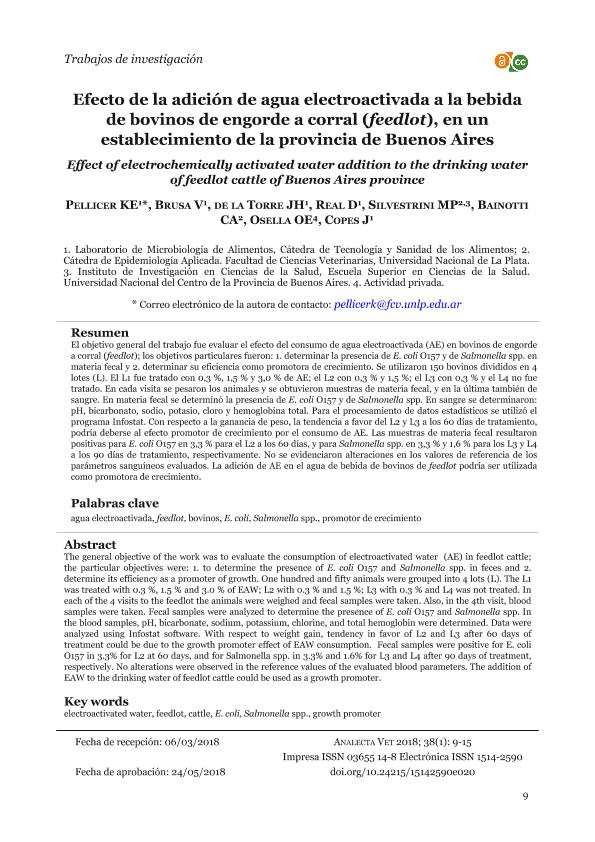Artículo
El objetivo general del trabajo fue evaluar el efecto del consumo de agua electroactivada (AE) en bovinos de engorde a corral (feedlot); los objetivos particulares fueron: 1. determinar la presencia de E. coli O157 y de Salmonella spp. en materia fecal y 2. determinar su eficiencia como promotora de crecimiento. Se utilizaron 150 bovinos divididos en 4 lotes (L). El L1 fue tratado con 0,3 %, 1,5 % y 3,0 % de AE; el L2 con 0,3 % y 1,5 %; el L3 con 0,3 % y el L4 no fue tratado. En cada visita se pesaron los animales y se obtuvieron muestras de materia fecal, y en la última también de sangre. En materia fecal se determinó la presencia de E. coli O157 y de Salmonella spp. En sangre se determinaron: pH, bicarbonato, sodio, potasio, cloro y hemoglobina total. Para el procesamiento de datos estadísticos se utilizó el programa Infostat. Con respecto a la ganancia de peso, la tendencia a favor del L2 y L3 a los 60 días de tratamiento, podría deberse al efecto promotor de crecimiento por el consumo de AE. Las muestras de materia fecal resultaron positivas para E. coli O157 en 3,3 % para el L2 a los 60 días, y para Salmonella spp. en 3,3 % y 1,6 % para los L3 y L4 a los 90 días de tratamiento, respectivamente. No se evidenciaron alteraciones en los valores de referencia de los parámetros sanguíneos evaluados. La adición de AE en el agua de bebida de bovinos de feedlot podría ser utilizada como promotora de crecimiento. The general objective of the work was to evaluate the consumption of electroactivated water (AE) in feedlot cattle; the particular objectives were: 1. to determine the presence of E. coli O157 and Salmonella spp. in feces and 2. determine its efficiency as a promoter of growth. One hundred and fifty animals were grouped into 4 lots (L). The L1 was treated with 0.3 %, 1.5 % and 3.0 % of EAW; L2 with 0.3 % and 1.5 %; L3 with 0.3 % and L4 was not treated. In each of the 4 visits to the feedlot the animals were weighed and fecal samples were taken. Also, in the 4th visit, blood samples were taken. Fecal samples were analyzed to determine the presence of E. coli O157 and Salmonella spp. In the blood samples, pH, bicarbonate, sodium, potassium, chlorine, and total hemoglobin were determined. Data were analyzed using Infostat software. With respect to weight gain, tendency in favor of L2 and L3 after 60 days of treatment could be due to the growth promoter effect of EAW consumption. Fecal samples were positive for E. coli O157 in 3.3% for L2 at 60 days, and for Salmonella spp. in 3.3% and 1.6% for L3 and L4 after 90 days of treatment, respectively. No alterations were observed in the reference values of the evaluated blood parameters. The addition of EAW to the drinking water of feedlot cattle could be used as a growth promoter.
Efecto de la adición de agua electroactivada a la bebida de bovinos de engorde a corral (feedlot), en un establecimiento de la provincia de Buenos Aires
Título:
Effect of electrochemically activated water addition to the drinking water of feedlot cattle of Buenos Aires province
Pellicer, Karina; Brusa, Victoria ; de la Torre, Julian Horacio; Real, Daniel Andres
; de la Torre, Julian Horacio; Real, Daniel Andres ; Silvestrini, Maria Pia; Bainotti, C.A.; Osella, O. E.; Copes, Julio Alberto
; Silvestrini, Maria Pia; Bainotti, C.A.; Osella, O. E.; Copes, Julio Alberto
 ; de la Torre, Julian Horacio; Real, Daniel Andres
; de la Torre, Julian Horacio; Real, Daniel Andres ; Silvestrini, Maria Pia; Bainotti, C.A.; Osella, O. E.; Copes, Julio Alberto
; Silvestrini, Maria Pia; Bainotti, C.A.; Osella, O. E.; Copes, Julio Alberto
Fecha de publicación:
07/2018
Editorial:
Universidad Nacional de La Plata. Facultad de Ciencias Veterinarias
Revista:
Analecta Veterinaria
ISSN:
1514-2590
Idioma:
Español
Tipo de recurso:
Artículo publicado
Clasificación temática:
Resumen
Archivos asociados
Licencia
Identificadores
Colecciones
Articulos(IGEVET)
Articulos de INST.DE GENETICA VET ING FERNANDO NOEL DULOUT
Articulos de INST.DE GENETICA VET ING FERNANDO NOEL DULOUT
Citación
Pellicer, Karina; Brusa, Victoria; de la Torre, Julian Horacio; Real, Daniel Andres; Silvestrini, Maria Pia; et al.; Efecto de la adición de agua electroactivada a la bebida de bovinos de engorde a corral (feedlot), en un establecimiento de la provincia de Buenos Aires; Universidad Nacional de La Plata. Facultad de Ciencias Veterinarias; Analecta Veterinaria; 38; 1; 7-2018; 9-15
Compartir
Altmétricas



